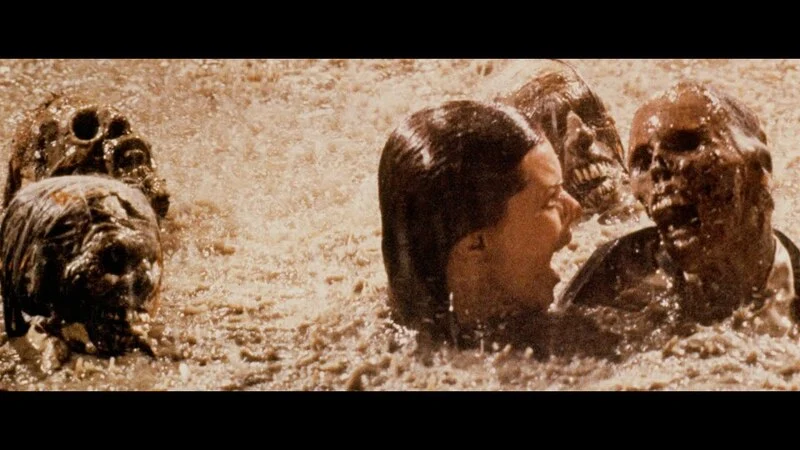The 1982 movie “Poltergeist,” directed by Tobe Hooper and produced by Steven Spielberg, is a seminal work in the horror genre. Known for its terrifying plot, groundbreaking special effects, and real-life eerie occurrences, one of the most enduring and controversial aspects of the film is the use of real human skeletons during its production. This article delves into the history, context, production details, controversies, and the broader implications of such practices in the film industry.
Introduction to “Poltergeist
“Poltergeist” was released on June 4, 1982, and quickly became a box-office hit. The film tells the story of the Freeling family, who experience a series of terrifying supernatural events in their suburban home. The plot revolves around their youngest daughter, Carol Anne, who becomes the focus of malevolent spirits. The film’s success is due to its blend of supernatural horror and relatable family dynamics.
The Scene in Question
The controversy regarding the use of real skeletons centers on a particular scene where Diane Freeling, played by JoBeth Williams, is dragged into a muddy pool filled with skeletons. During the production, it was revealed that these skeletons were real human remains, a revelation confirmed by Williams and special effects artist Craig Reardon.
Historical Context of Using Real Skeletons in Film
Using real skeletons in movies was not uncommon during the early days of Hollywood. It was often cheaper and more convenient to obtain real human skeletons from medical supply companies than to create realistic props. Films like “House on Haunted Hill” (1959) and “The House of Frankenstein” (1944) reportedly used real skeletons. However, ethical considerations and public awareness have evolved significantly since then, leading to increased scrutiny of such practices.
Production Details and Confirmation
Testimonies from the Cast and Crew
JoBeth Williams has recounted her experience filming the pool scene, stating she was unaware the skeletons were real until after the scene was shot. Special effects artist Craig Reardon has also confirmed the use of real skeletons, explaining they were obtained from a medical supply company and were more cost-effective than plastic replicas.
Ethical and Legal Implications
The use of real human remains in film raises several ethical and legal questions. While the practice may have been more commonplace and less scrutinized in the past, modern standards in the film industry place a greater emphasis on ethical considerations and the respectful treatment of human remains. The revelations about “Poltergeist” have sparked debates about the responsibilities of filmmakers and the importance of transparency in production practices.
The “Poltergeist” Curse
Tragic Events Surrounding the Film
The use of real skeletons has often been linked to the so-called “Poltergeist Curse,” a series of unfortunate and tragic events that befell several cast members. Most notably, Heather O’Rourke, who played the young Carol Anne, died at the age of 12 due to complications from an acute bowel obstruction. Dominique Dunne, who played her older sister, Dana, was murdered by her ex-boyfriend shortly after the film’s release.
Superstition vs. Reality
While some attribute these tragedies to a curse, others argue they are coincidental and unrelated to the film’s production. The notion of a curse has been perpetuated by the media and remains a topic of fascination for fans and scholars of horror cinema.
Broader Implications for the Film Industry
Changes in Industry Standards
The revelations about the use of real skeletons in “Poltergeist” have contributed to changes in industry standards regarding the use of human remains and props in film. Modern productions are more likely to use advanced special effects and high-quality replicas to achieve realism without ethical compromises.
Impact on the Horror Genre
The controversy has also influenced the horror genre, prompting filmmakers to consider the ethical implications of their creative choices. The use of real skeletons in “Poltergeist” adds a layer of authenticity to the film’s horror but also raises questions about the lengths to which filmmakers should go to achieve realism.
The Legacy of “Poltergeist”
Critical and Cultural Reception
“Poltergeist” continues to be celebrated for its innovative special effects, compelling storytelling, and lasting impact on the horror genre. The film has spawned several sequels and a remake, solidifying its place in popular culture.
Lessons Learned
The controversy surrounding the use of real skeletons serves as a reminder of the importance of ethical considerations in filmmaking. It highlights the need for transparency and respect in the treatment of human remains and underscores the evolving standards in the film industry.
The Reality Behind the Skeletons
Practicality vs. Morality
In the early 1980s, the use of real skeletons was often seen as a practical choice. They were cheaper and more readily available than creating realistic plastic or rubber models. However, the decision to use real human remains in a film, especially in a horror context, raises significant moral and ethical questions.
Medical Supply Companies
Special effects artist Craig Reardon explained that the skeletons used in “Poltergeist” were obtained from medical supply companies, which legally sold human remains for educational and professional use. This practice was not illegal, but it was certainly controversial, especially when used for entertainment purposes.
Ethical Considerations
Respect for the Deceased
Using real human remains in films, especially for horror, can be seen as disrespectful to the deceased and their families. While the skeletons were legally obtained, the context in which they were used – to frighten and entertain – can be perceived as demeaning.
Changing Perceptions
As societal norms and values evolve, the use of real human remains in entertainment has become increasingly controversial. Modern audiences and industry professionals are more aware of the ethical implications and are less likely to condone such practices.
Legal Ramifications
Laws and Regulations
While the use of real skeletons was not illegal at the time, modern laws and regulations regarding the use of human remains are much stricter. Today, filmmakers must adhere to ethical guidelines and legal requirements to ensure the respectful treatment of human remains.
Industry Standards
The film industry has developed standards and practices to avoid ethical controversies. The use of advanced special effects and high-quality replicas allows filmmakers to achieve realism without compromising ethical standards.
The Cultural Impact of “Poltergeist”
Influence on Horror Cinema
“Poltergeist” has had a profound influence on the horror genre. Its blend of supernatural horror and family drama set a new standard for horror films. The controversy surrounding the use of real skeletons adds an extra layer of intrigue and horror to the film’s legacy.
Public Fascination
The use of real skeletons and the subsequent “Poltergeist Curse” have captivated the public imagination for decades. The film’s eerie production stories and tragic events have contributed to its lasting cultural impact.
The “Poltergeist” Curse Revisited
Examining the Evidence
The tragic events surrounding the “Poltergeist” series, including the deaths of cast members Heather O’Rourke and Dominique Dunne, have been attributed by some to a curse. However, examining the evidence reveals that these events, while tragic, may be coincidental.
Media Sensationalism
The media has played a significant role in perpetuating the idea of a “Poltergeist Curse.” Sensational stories and speculation have fueled public interest, but it’s essential to distinguish between fact and fiction.
The Evolution of Horror Filmmaking
Advancements in Special Effects
Since the release of “Poltergeist,” advancements in special effects have transformed the horror genre. Filmmakers now have access to sophisticated technology that allows them to create realistic and terrifying scenes without the ethical concerns of using real human remains.
Ethical Filmmaking
Modern horror filmmakers are more conscious of ethical considerations. The lessons learned from past controversies have led to a more respectful and responsible approach to creating horror films.
Behind the Scenes: Creating “Poltergeist”
Production Challenges
The production of “Poltergeist” was fraught with challenges, from technical difficulties to the physical demands placed on the actors. The use of real skeletons in the pool scene was just one of many challenges faced by the filmmakers.
Innovative Techniques
Despite the challenges, “Poltergeist” is celebrated for its innovative special effects and groundbreaking techniques. The film’s success is a testament to the creativity and dedication of its cast and crew.
Audience Reactions
Initial Reception
Upon its release, “Poltergeist” was met with critical acclaim and commercial success. Audiences were captivated by its terrifying plot and impressive special effects.
Long-Term Impact
Over the years, “Poltergeist” has maintained its status as a classic horror film. Its impact on the genre and its cultural significance continue to resonate with new generations of audiences.
Reflecting on “Poltergeist” Today
Cultural Legacy
“Poltergeist” remains a significant cultural artifact, reflecting the fears and anxieties of its time. Its legacy is a blend of cinematic innovation and ethical controversy.
Lessons for Future Filmmakers
The story of “Poltergeist” offers valuable lessons for future filmmakers. It underscores the importance of ethical considerations and the need for transparency in the filmmaking process.
Appendix: Detailed Examination of Key Scenes
The Pool Scene
The infamous pool scene in “Poltergeist” is a pivotal moment in the film. As Diane Freeling is dragged into a muddy pool filled with skeletons, the terror is palpable. The use of real skeletons in this scene adds an extra layer of horror, both on and off the screen.
Special Effects and Realism
Special effects artist Craig Reardon explained that real skeletons were used to achieve a higher level of realism. While plastic replicas were available, they lacked the authenticity needed for the scene.
Appendix: Ethical Considerations in Modern Filmmaking
Guidelines and Standards
Today, the film industry has established guidelines and standards to ensure ethical practices in filmmaking. These standards help protect the dignity of human remains and promote responsible filmmaking.
Respecting Cultural Sensitivities
Filmmakers must also consider cultural sensitivities when depicting human remains. Respecting diverse cultural practices and beliefs is essential in creating responsible and respectful films.
Appendix: The Impact of Media Sensationalism
Shaping Public Perception
The media plays a significant role in shaping public perception of films and their production stories. Sensational stories about the “Poltergeist Curse” have fueled public interest and contributed to the film’s lasting legacy.
Balancing Fact and Fiction
While sensational stories can captivate audiences, it’s essential to balance fact and fiction. Understanding the true story behind the production of “Poltergeist” provides a more accurate and nuanced perspective.
Appendix: Advances in Special Effects Technology
From Practical Effects to CGI
The transition from practical effects to computer-generated imagery (CGI) has transformed the film industry. Modern special effects allow filmmakers to create realistic and terrifying scenes without ethical concerns.
The Future of Horror Filmmaking
As technology continues to advance, the future of horror filmmaking looks promising. Filmmakers can achieve greater levels of realism and creativity while adhering to ethical standards.
Appendix: Reflections from Cast and Crew
JoBeth Williams’ Perspective
JoBeth Williams has shared her reflections on the production of “Poltergeist.” Her experiences highlight the challenges and rewards of working on such an iconic film.
Craig Reardon’s Insights
Special effects artist Craig Reardon has provided valuable insights into the decision to use real skeletons. His perspective sheds light on the practical considerations and ethical implications of the choice.
Conclusion
The 1982 movie “Poltergeist” is a landmark in horror cinema, not only for its supernatural thrills and special effects but also for the enduring controversy over its use of real skeletons. This practice, while historically common, raises important ethical and legal questions that continue to resonate in the film industry today. The legacy of “Poltergeist” is a testament to the power of storytelling and the importance of ethical responsibility in filmmaking.
“Poltergeist” remains a landmark film in the horror genre. Its legacy is a blend of cinematic innovation, ethical controversy, and cultural impact. As the film industry continues to evolve, the lessons learned from “Poltergeist” serve as a reminder of the importance of ethical responsibility and the power of storytelling. If you have any questions, please visit the Kaz World Mag.

